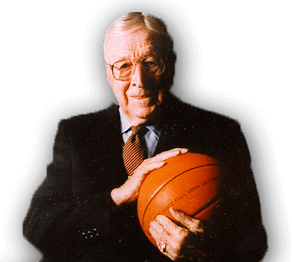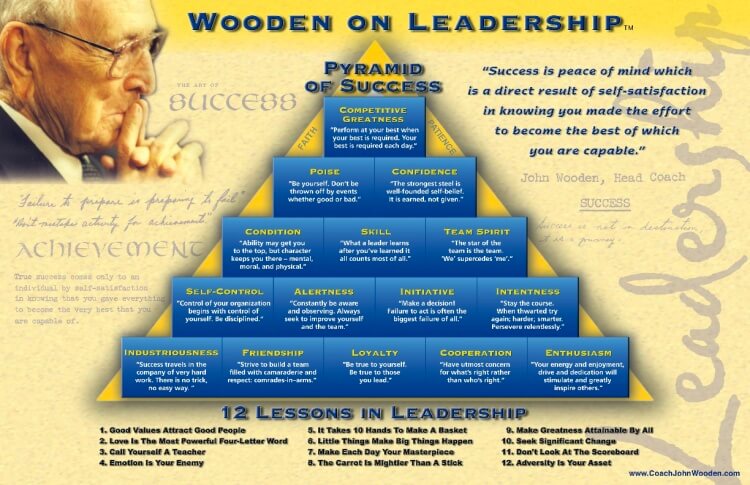Arguably, there has been no greater role model for coaches in any sport than legendary coach John Wooden (Gilbert, 2010). Often considered the greatest coach of all time (Nater & Gallimore, 2010), Wooden has been inducted into the Basketball Hall of Fame both as a player and a coach (Davis, 2014). He won ten NCAA basketball championships from 1964 to 1975 as the Head Men’s Basketball Coach at UCLA (Jenkins, 2014).

In 1999, a panel of ESPN experts named him the greatest collegiate coach of the 20th Century (Ermeling, 2012), and in 2003 he received the Presidential Medal of Freedom from the United States Government (Gilbert, 2010). In his retirement, Wooden became a best-selling author and was a sought after keynote speaker well into his late 90’s.
Researchers, established authors, and former players have written about Wooden’s leadership style (Gilbert, Nater, Siwik, & Gallimore, 2010; Jenkins, 2014; Wooden & Jamison, 2005), teaching methodology (Ermeling, 2012; Gallimore & Tharp, 2004; Nater & Gallimore, 2010), faith (Wooden & Carty, 2003), and the impact he had on student-athletes under his leadership (Hill & Wooden, 2001). In a new biography released this past January, Sports Illustrated writer Seth Davis (2014) presents a complete biographical view of Coach Wooden’s life, highlighting his competitive fire, drive to succeed, personal challenges, and introverted personality.
In Wooden: A Coach’s Life, Davis (2014) chronicles Wooden’s humble beginnings in Martinsville, Indiana to how he transformed the UCLA men’s basketball program into a national power. Intriguingly, the biography often portrays Coach Wooden in less of a legendary perspective and more like a common coach, especially in his early years.
He was, in short, a hard to please, detail-obsessed, hyper-organized taskmaster and control freak. He could be brutal on referees. He may have mostly stayed in his chair, but he maintained a running dialogue with the officials (Davis, 2014, p. 64).
While his drive to succeed and pursue excellence may mimic the personality of thousands of coaches, there always seems to be something about Coach Wooden that captivates us. For some, it was his value-driven leadership style.
During a game at Stanford in February, Taft was fouled as he drove for a layup. He missed the shot, but as the referees momentarily looked away, Naulls reached up and tipped the ball in. The officials thought that Taft had made his shot and awarded him a 3-point opportunity. That brought jeers of protest from the Stanford players, coaches, and fans.
After one of the Stanford players told a referee what he had seen, the official then asked Naulls if it really was he, and not Taft, who had put the ball in. Naulls looked at Wooden, but the coach said nothing. So Naulls told the referee the truth. The basket was waved off, and UCLA eventually won in overtime as Naulls scored 37 points.
Many years later, Naulls reminded Wooden of that moment and asked the coach if he thought he had done the right thing that night. Wooden carefully laid out all the various considerations before concluding, “A man has to make up his own mind in a situation that affects so many others.” Naulls took that as a “yes” (Davis, 2014, p. 151).
Wooden inspired others with his Pyramid of Success, 15 blocks and 5 tiers providing as Wooden stated, “specific directions on how those under my supervision could achieve success by realizing their own potential, both individually and as part of a team (Wooden & Jamison, 2005, p.19).

Today, the Pyramid of Success reaches beyond sport and inspires leaders in business and education (Gilbert, 2010). Regardless of one’s reason for seeking leadership guidance from Coach Wooden, his influence is almost beyond comparison (Gilbert, 2010). In fact, it makes you wonder how did he remain true to his values and beliefs? Furthermore, how was he able to create and subsequently implement the pyramid of success?
As discussed in many of his books (Wooden & Jamison, 1997; Wooden & Jamison, 2005), Coach Wooden’s values and beliefs were heavily influenced by the teachings of his father, Hugh.
Above all else, Hugh imbued his sons with a core philosophy that would guide Johnny throughout his childhood, his marriage, and especially his playing and coaching careers. It was a gospel that would come to define John more than any other. “Dad tried to get across to us never try to be better than someone else. Learn from others and never cease trying to be the best you can be at whatever you’re doing, he said…If you get yourself too engrossed in things over which you have no control, it’s going to adversely affect the things over which you have control” (Davis, 2014, p.10).
With his father’s guidance ingrained in him, Wooden learned to focus on what he could control and avoided comparing himself to others. Former UCLA player Ralph Joeckel explained how Coach Wooden stayed true to this approach.
…he did not spend time talking with his players about the other team. ‘He gave us a tremendous amount of self-confidence,’ Joeckel said. ‘We basically got to the point where the other team was nothing to us. He didn’t belittle them in any way, but he had us ignore them so much that in my mind, I didn’t have any use for the other team’ (Davis, 2014, p. 115).
Early in his teaching and coaching career, with his father’s values firmly embedded in his character, Wooden ‘coined’ his definition of success based on what he could control. “Success is a peace of mind that is the direct result of self-satisfaction in knowing you did your best to become the best that you are capable of becoming” (Wooden & Jamison, 1997, p.170). This definition became the driving force of Wooden’s leadership philosophy, occupying the top tier of the Pyramid of Success.
Interestingly, the commitment and diligence he demonstrated in building his leadership philosophy based on the Pyramid of Success, exposes a key characteristic of Coach Wooden that may have been the driving force behind his long-term success.
In the years since Wooden was in Dayton Kentucky, he had continued to rework his pyramid in small significant ways. He kept the blocks in the same order, but he introduced phrases that explained their meaning and he frequently massaged those words…After fourteen years of tinkering, Wooden decided his pyramid was complete (Davis, 2014, p.80).
Similar to his continuous work over fourteen years on the Pyramid of Success, Coach Wooden often demonstrated the ability to adapt and reflect on his experiences, taking the necessary steps to get better (Nater & Gallimore, 2010).
Immediately after accepting the head coaching position at UCLA in 1948, Coach Wooden began to employ an organized research and development system, which allowed him to make substantial improvements each year in how he taught basketball. At the conclusion of each basketball season, during the off-season his self-improvement research began. He chose only one topic for each off-season study…the goal was to uncover all he could learn about a specific subject, draw conclusions, and apply it to his teaching (p. 43).
This approach served him well in a variety of scenarios he faced in coaching. It also allowed him to keep an open mind and learn from his mistakes. His desire to continually develop and improve his craft as a basketball coach, sheds light on how he was able to create the Pyramid of Success and develop the skills needed to sustain long-term success as a coach.
One of Coach Wooden’s favorite maxims was, “it’s what you learn after you know it all that counts most” (Wooden & Jamison, 2005, p.46). Remarkably, Coach Wooden’s desire to be a life-long learner may have had the greatest impact on his success as a leader. Even well into his retirement, he continued to learn. Seth Davis (2014) describes a visit to Coach Wooden’s apartment…
Before I walked through the door, they were there to greet me in tall, neat piles in the front hallway. The books were stacked on floors, lined up on tables, piled on desks, and jammed into bookcases. The apartment was barely two thousand square feet, yet it seemed that most of it was covered by something that could be read (p. 1).
Coaches, teachers, and leaders in all professions will continue to seek guidance and direction from the teachings of Coach Wooden captured in books, articles, videos, and personal stories. But, what they are searching for may best be illustrated in their interest in Coach Wooden – the desire to continue learning.
